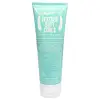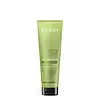What's inside
What's inside
 Benefits
Benefits

 Concerns
Concerns

 Ingredients Side-by-side
Ingredients Side-by-side

Water
Skin ConditioningGlycerin
HumectantEmulsifying Wax Nf
Amodimethicone
Cetrimonium Chloride
AntimicrobialTrideceth-12
EmulsifyingBehentrimonium Chloride
PreservativeHamamelis Virginiana Water
AstringentAloe Barbadensis Leaf Extract
EmollientHydrolyzed Wheat Protein/Pvp Crosspolymer
Triticum Vulgare Germ Oil
EmollientPersea Gratissima Oil
Skin ConditioningCarthamus Tinctorius Seed Oil
MaskingGuar Hydroxypropyltrimonium Chloride
Skin ConditioningHydroxypropyl Methylcellulose
Emulsion StabilisingMethyl Gluceth-20
HumectantSilk Amino Acids
HumectantEthylhexyl Methoxycinnamate
UV AbsorberPhenoxyethanol
PreservativeCaprylyl Glycol
EmollientCitric Acid
BufferingParfum
MaskingHc Yellow No. 10
Water, Glycerin, Emulsifying Wax Nf, Amodimethicone, Cetrimonium Chloride, Trideceth-12, Behentrimonium Chloride, Hamamelis Virginiana Water, Aloe Barbadensis Leaf Extract, Hydrolyzed Wheat Protein/Pvp Crosspolymer, Triticum Vulgare Germ Oil, Persea Gratissima Oil, Carthamus Tinctorius Seed Oil, Guar Hydroxypropyltrimonium Chloride, Hydroxypropyl Methylcellulose, Methyl Gluceth-20, Silk Amino Acids, Ethylhexyl Methoxycinnamate, Phenoxyethanol, Caprylyl Glycol, Citric Acid, Parfum, Hc Yellow No. 10
Water
Skin ConditioningCetearyl Alcohol
EmollientCetyl Esters
EmollientAmodimethicone
Behentrimonium Chloride
PreservativePhenoxyethanol
PreservativeParfum
MaskingSorbitol
HumectantIsopropyl Alcohol
SolventTrideceth-6
EmulsifyingHydrolyzed Soy Protein
HumectantMoringa Oleifera Seed Oil
EmollientHydrolyzed Vegetable Protein Pg-Propyl Silanetriol
Skin ConditioningArginine
MaskingCitric Acid
BufferingCetrimonium Chloride
AntimicrobialChlorhexidine Dihydrochloride
AntimicrobialHexyl Cinnamal
PerfumingLinalool
PerfumingEthylhexyl Methoxycinnamate
UV AbsorberLimonene
PerfumingCoumarin
PerfumingBenzyl Alcohol
PerfumingWater, Cetearyl Alcohol, Cetyl Esters, Amodimethicone, Behentrimonium Chloride, Phenoxyethanol, Parfum, Sorbitol, Isopropyl Alcohol, Trideceth-6, Hydrolyzed Soy Protein, Moringa Oleifera Seed Oil, Hydrolyzed Vegetable Protein Pg-Propyl Silanetriol, Arginine, Citric Acid, Cetrimonium Chloride, Chlorhexidine Dihydrochloride, Hexyl Cinnamal, Linalool, Ethylhexyl Methoxycinnamate, Limonene, Coumarin, Benzyl Alcohol
Ingredients Explained
These ingredients are found in both products.
Ingredients higher up in an ingredient list are typically present in a larger amount.
This water-soluble silicone is used for its hydrating and softening properties. It is used to add a silky feel to skincare products and has great benefits for haircare.
In haircare, this ingredient:
- Adds shine
- Protects color
- Offers thermal protection
- Boosts hair strength
- Does not build up as easily
This ingredient is a preservative and often used for it's anti-static properties. You'll most likely see this ingredient in hair conditioners.
It does not cause irritation or sensitization in leave-on products at 1-5%.
This ingredient is a preservative, antimicrobial, and emulsifier. It is often used in cosmetics for its ability to cleanse, condition, and reduce static.
Cetrimonium chloride is a quaternary ammonium salt, meaning it has a water-soluble structure.
Citric Acid is an alpha hydroxy acid (AHA) naturally found in citrus fruits like oranges, lemons, and limes.
Like other AHAs, citric acid can exfoliate skin by breaking down the bonds that hold dead skin cells together. This helps reveal smoother and brighter skin underneath.
However, this exfoliating effect only happens at high concentrations (20%) which can be hard to find in cosmetic products.
Due to this, citric acid is usually included in small amounts as a pH adjuster. This helps keep products slightly more acidic and compatible with skin's natural pH.
In skincare formulas, citric acid can:
While it can provide some skin benefits, research shows lactic acid and glycolic acid are generally more effective and less irritating exfoliants.
Most citric acid used in skincare today is made by fermenting sugars (usually from molasses). This synthetic version is identical to the natural citrus form but easier to stabilize and use in formulations.
Read more about some other popular AHA's here:
Learn more about Citric AcidEthylhexyl Methoxycinnamate is an organic compound that provides UVB protection. It often goes by the more common name of octinoxate. It is created from methoxycinnamic acid and 2-ethylhexanol.
Ethylhexyl Methoxycinnamate absorbs UVB rays with wavelengths between 280-320 nm. UV absorbers protect your skin by using chemical reactions to convert UV rays into heat and energy.
UVB (290-320 nm) rays emit more energy than UVA rays. They are capable of damaging DNA, causing sunburns and are thought to be linked to skin cancer.
The state of Hawaii has banned sunscreens containing octinoxate due to its potential impact on coral reefs. More research is needed to bridge gaps in this research. The European Union allows higher levels of octinoxate in sunscreens than the US and Australia.
Ethylhexyl Methoxycinnamate is oil soluble. It is not stable and may lose efficacy when exposed to sunlight.
Learn more about Ethylhexyl MethoxycinnamateParfum is a catch-all term for an ingredient or more that is used to give a scent to products.
Also called "fragrance", this ingredient can be a blend of hundreds of chemicals or plant oils. This means every product with "fragrance" or "parfum" in the ingredients list is a different mixture.
For instance, Habanolide is a proprietary trade name for a specific aroma chemical. When used as a fragrance ingredient in cosmetics, most aroma chemicals fall under the broad labeling category of “FRAGRANCE” or “PARFUM” according to EU and US regulations.
The term 'parfum' or 'fragrance' is not regulated in many countries. In many cases, it is up to the brand to define this term.
For instance, many brands choose to label themselves as "fragrance-free" because they are not using synthetic fragrances. However, their products may still contain ingredients such as essential oils that are considered a fragrance by INCI standards.
One example is Calendula flower extract. Calendula is an essential oil that still imparts a scent or 'fragrance'.
Depending on the blend, the ingredients in the mixture can cause allergies and sensitivities on the skin. Some ingredients that are known EU allergens include linalool and citronellol.
Parfum can also be used to mask or cover an unpleasant scent.
The bottom line is: not all fragrances/parfum/ingredients are created equally. If you are worried about fragrances, we recommend taking a closer look at an ingredient. And of course, we always recommend speaking with a professional.
Learn more about ParfumPhenoxyethanol is a preservative that has germicide, antimicrobial, and aromatic properties. Studies show that phenoxyethanol can prevent microbial growth. By itself, it has a scent that is similar to that of a rose.
It's often used in formulations along with Caprylyl Glycol to preserve the shelf life of products.
Water. It's the most common cosmetic ingredient of all. You'll usually see it at the top of ingredient lists, meaning that it makes up the largest part of the product.
So why is it so popular? Water most often acts as a solvent - this means that it helps dissolve other ingredients into the formulation.
You'll also recognize water as that liquid we all need to stay alive. If you see this, drink a glass of water. Stay hydrated!
Learn more about Water